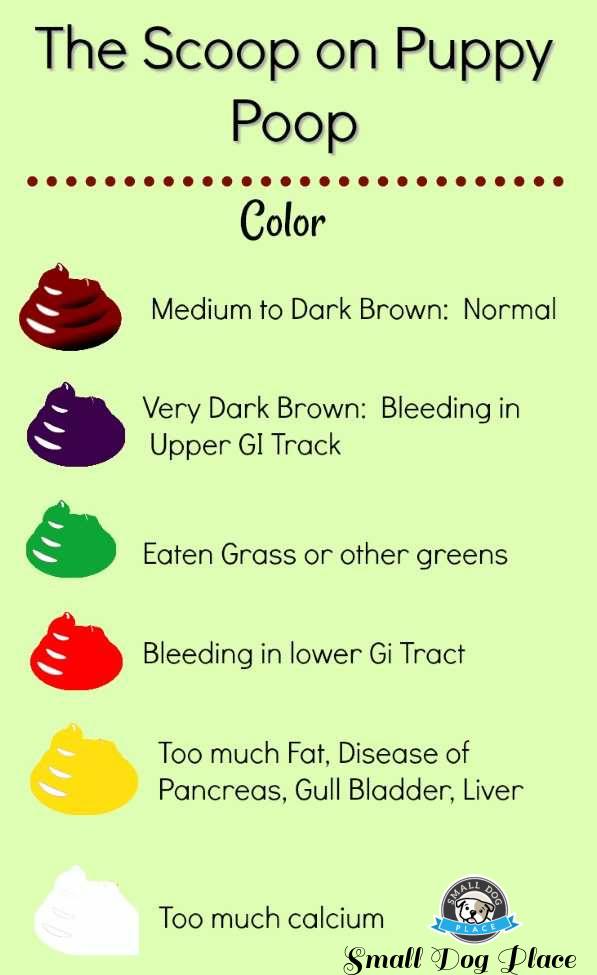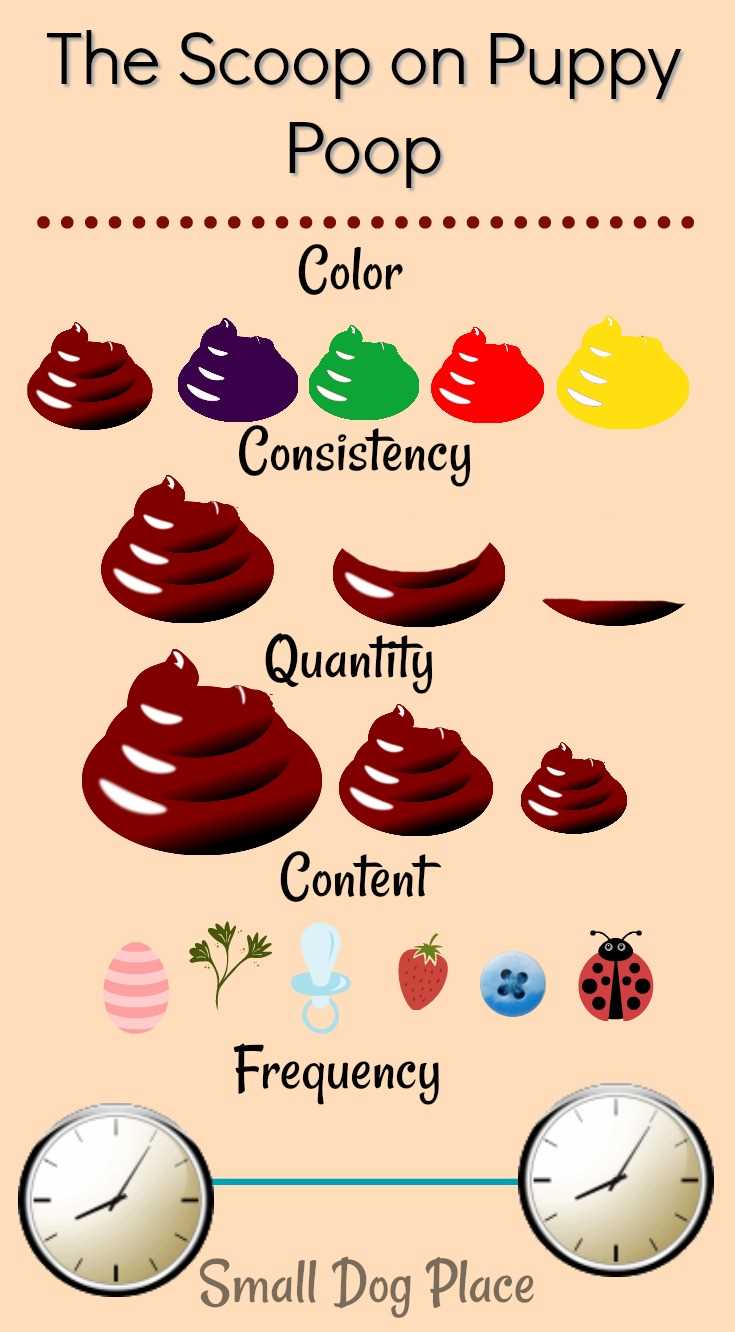- Small Dog Place Home
- Health
- Puppy Poop
Puppy Poop - Doggie Poop: The Good, the Bad, and the Smelly-What Does it All Mean?
By Janice A. Jones |Last Updated 11-22-2021
Dog excrement can tell much about the health of the puppy or dog. Now, I don't want you to think I'm an expert, but one thing about breeding dogs is you get to care for a lot of puppies. AND, I mean a lot and with puppies comes poop.
When I had my first dream about poop, I decided that it was time to learn more and that is what this guide is all about.
Your comprehensive Puppy Poop Guide.
Table of Contents
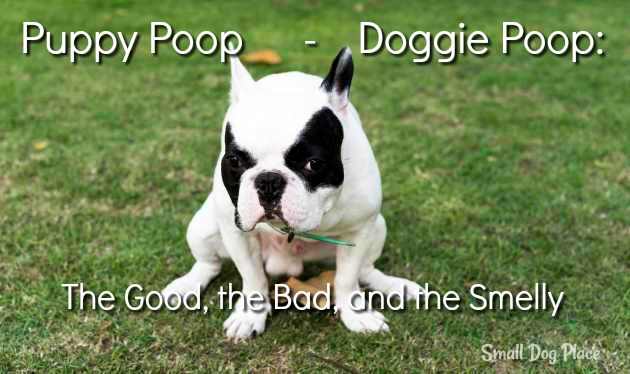
Differences in Puppy Poop
Most people get alarmed if their puppy is showing signs of constipation or diarrhea, and they should. These problems can get out of control very quickly if not dealt with in a timely manner.
But sometimes we see poop that just looks all wrong. How do we evaluate these differences.
Evaluating puppy poop, your first job is to observe it's color, consistency, quantity, content, coating, and frequency.
The Color of Puppy Poop
A healthy stool has a color that ranges from medium to dark brown in color. It should not be white, red, green, gray or a black tarry color.
My Puppy's Poop is Very Dark
A very dark color, almost black could mean that there is some bleeding occurring high in the intestinal tract which could indicate stomach or small intestine problems such as a stomach ulcer, cancer, or a tumor.
Dog Poop is red or Blood Streaked
A red tinge or actual red blood in the stool could indicate bleeding in the lower intestinal tract. Bleeding may be coming from the large intestine or the anal glands.
If there is large quantities of blood, seek emergency veterinary treatment as it could be something has torn the lining of the intestinal tract or something such as a tumor erupted.
Sometimes the stool is slightly discolored because the dog has eaten something that has a strong color. Some medications can also change the color of the stool.
Some intestinal parasites, especially giardia and coccidia produce blood in the stool. The only way to rule out parasites is to have a fecal run by your vet.
Parvo is often accompanied by bloody diarrhea which would also indicate a medical emergency.
Puppy Poop always has an odor, but poop containing blood has a stronger nastier smell that can't be ignored.
Gray or Yellow Puppy Poop
Rarely you may notice a grey or yellow color to your puppy's poop. According to VetStreet, this indicates a liver problem, gallbladder, liver or pancreatitis which needs to be checked out immediately with your vet. It can also indicate a food intolerance which mean changing your dog food.
Green Puppy Poop
A large quantity of green material may mean that your puppy is eating grass. Grass is not bad per se but it could indicate an upset stomach.
White Puppy Poop
A stool that has been sitting on the ground for a few days will turn lighter in color, often white.
That is normal.
Also normal according to Pet People Place, a puppy or dog with too much calcium in the diet such as eating too many bones or a dog on a completely raw diet.
The other reasons why a dog's poop might be white is ingesting foreign objects such as toilet paper or paper towels. A bit of puppy proofing can help with this issue.
Little bits of paper can find their way through the GI tract and may show up in the stool. Normally this is no cause for concern unless your puppy becomes very constipated. Severe constipation in this case could indicate a blockage and a vet should be consulted.
A brown stool with bits of white may mean worms. Tapeworms will shed segments that appear like white rice grains. Sometimes you will find long strains resembling spaghetti. Those are roundworms. Any type of parasite needs worming medicine.
Consistency Variations in Puppy Poop
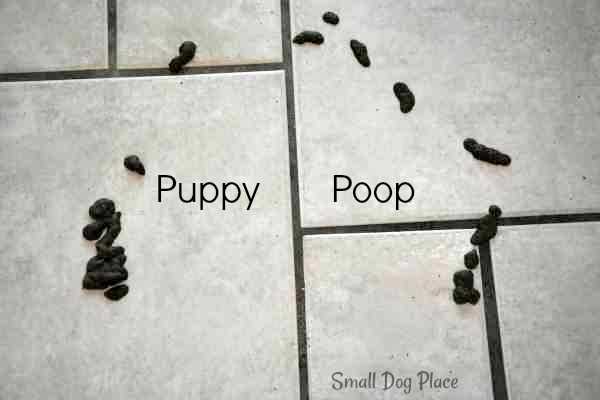 This poop may look formed, but it is actually diarrhea. The puppy was walking and pooping at the same time.
This poop may look formed, but it is actually diarrhea. The puppy was walking and pooping at the same time.The consistency of normal stools is firm, but not soft or hard and shaped like a log. You should be able to differentiate segments in the stool.
Diarrhea
Without these segments and firm consistency, the stool may be too soft. When the consistency is even softer, you will observe a puddle of poop. This is not normal. Neither is a liquid puddle that has no form at all.
Too soft or formless? This indicates there is a problem within the intestinal tract where excess water is not being reabsorbed. In the case of puppies, there may be a parasite infestation.
Diarrhea can be further divided into the type of consistence and is most important in determining whether a puppy should visit the vet.
Diarrhea that looks soft and non formed, but does not show any signs of blood or mucus may be the result of diet or ingestion of something other than puppy or dog food.
As mentioned above, gray stools that appear greasy may mean too much fat in the diet. A one day indiscretion should not pose a problem but if it continues, it could mean that the pancreas is inflamed. (Pancreatitis). This requires a visit to the vet's office.
Watery diarrhea is definitely a problem and should be addressed by your vet. It can indicate a viral infection such as Parvo or the presence of parasites.
If watery diarrhea accompanies vomiting, your dog may be in jeopardy for dehydration. Dehydration is a serious problem in puppies and may need emergency treatment.
Constipation
Too hard? When the stool is too hard, constipation may be a problem.
There are numerous causes of constipation. Stress is common in puppies, especially if the puppy is going to their new forever home. Lack of fiber in the diet can also cause constipation as can lack of water.
Puppies also love to chew and may swallow something, either the result of the chewing or another small object found on the floor. This could pose a choking hazard but if swallowed could cause a blockage.
Constipation follows.
If you suspect your puppy swallowed an object, the best way to find out if there is a problem is to examine the poop for the next 24 hours. Most small objects will pass, but if not, visit your veterinarian immediately.
Something simple like matted hair blocking the anus will cause constipation in short order. Clip or shave the hair around the puppy's anus to assure there is room for passing a stool.
In older dogs, constipation usually indicates a poor diet, lack of fluids, tumor, diabetes, or kidney disease.
Lack of exercise can also bring on constipation. In senior dogs, weak abdominal muscles may be the culprit.
Amount or Quantity
I know few owners that would take the time to measure the quantity of poop produced in a day. Normally this is not an issue as long as the consistency and color is normal.
Suffice it to say that the larger the dog, the more poop produced. But there is more to it than that. Diet plays a crucial role in the amount of stool produced.
Dogs that consume a low residue dog food will excrete less poop than those dogs that eat a typical moderate value dog food.
A low residue dog food is a formula that contains mostly digestible ingredients that can be easily metabolized by the body.
Highly digestible just means that most of the ingredients can be broken down during the digestive tract and those nutrients can be used by the body. What is not digested is excreted. Most low residue dog foods have a low fiber content.
Fiber is a carbohydrate, inserted by manufacturers to bulk up the stool and improve digestion. When there is excessive amounts of fiber, that is where you will see larger stools.
It gets a bit more complicated than that, though. There are two different kinds of fiber, soluble and insoluble. Soluble fiber can dissolve in water making it digestible. Insoluble can not be digested.
You would think that an dog food ingredient that contains an insoluble fiber would not be helpful, but that is not true.
Insoluble fibers absorb water and make the digestive process easier, thus reducing the likelihood of constipation.
Since low residue diets are often prescribed by veterinarians to treat dogs with digestive problems such as irritable bowel syndrome, the dog food often requires a prescription.
Even dogs that do not have any digestive upsets can benefit from a diet with less fiber. Foods that have a high protein percentage and moderate fat are less likely to have huge quantities of carbohydrates.
Types of dog food may also have an influence on the amount of poop produced. Dogs that eat dry kibble will produce the most poop. Canned and raw diets often cause the dog to produce less poop.
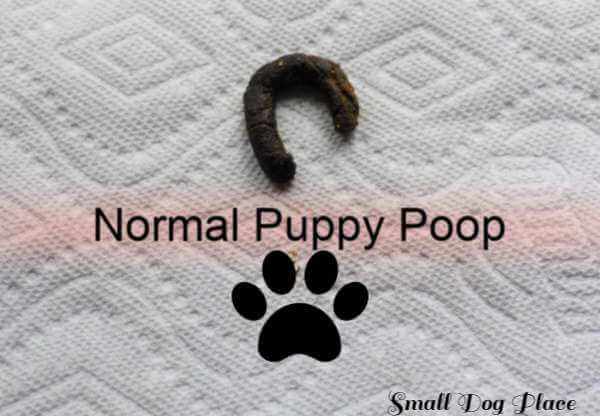 This is what normal puppy poop should look like.
This is what normal puppy poop should look like.Content of Puppy Poop
With puppies, there is no telling what they may swallow. Like human infants, puppies are very curious and will put anything in their mouth as they explore their environment.
Swallowed items, if passed successfully through the GI tract are often observed in the stool.
Unusual Swallowed Items:
Most people will not go farther than a visual examination of poop. However if you suspect your dog has eaten or swallowed something that they should not have, you may need to examine the poop for the suspect object.
For example, if you know your puppy swallowed a penny, you will want to know that the penny passed through the entire gastrointestinal tract and was deposited in the poop. That is a good sign and one that signifies a surgery doesn't need to be scheduled.
Intestinal Parasites
What if you are casually looking at your puppy's poop as you pick it up with your pooper scooper or poop bag and notice something that shouldn't be in the poop?
If you see tiny specks that look like rice, your puppy may have tapeworms. Long skinny spaghetti fragments may indicate roundworms.
Both tapeworms and roundworms sometimes appear in the stool and if that happens you know that your puppy has a parasite infestation that requires worming medicine.
Just because you do not notice any visual signs of worms, does not mean there are no parasites.
Natural Materials
Foreign natural objects are often seen in puppy poop. Many of these can be identified: grass, leaves, bits of bark, tiny sticks, birdseed or other seeds that have been digested are commonly found in poop.
Even tiny bits of plastic or stones may pass completely through the GI tract. Any of these items are not cause for alarm, but may be a problem if they continue to appear.
Just like humans, a small amount of dietary indiscretion can be overlooked, but when it becomes a daily occurrence or if it is accompanied by other symptoms, it needs to be addressed by a veterinarian.
Coating on Puppy Poop
Mucus or a filmy appearance on the poop is not normal on a puppy stool. If you see mucus covering the stool or red blood accompanying a stool may indicate an inflammation or a parasite infestation.
This should be observed and if it continues more than 24 hours, you should consult your vet for further examination. Mucus is often an indication of parasites.
Greasy appearance indicates fat in the diet, whether from some generous human handing out fat to the puppy or an actual medical problem.
Liver and pancreas issues are not often seen in young puppies, but a greasy look to the poop of an adult dog should be checked out. If the puppy's poop does not clear up within 24 hours, a sample should be submitted to the vet for examination.
Frequency of Puppy Poop
It is not unusual for a puppy to poop five times a day. The younger the puppy, the more frequently they will produce a bowel movement. As puppies age, frequency drops to just a couple per day and adults may only need to go once in 24 hours.
There is a great variation among individual dogs and what is normal for one may be a sign of concern to another.
The best advice I can give is to monitor your healthy puppy by counting the number of stools produced in a given 24 hour period. That way you will have a baseline from which to begin.
For puppies eating three meals a day, you are likely to see at least 3 stools but more is likely. If you are in the process of potty training, plan on taking your puppy out to urinate or defecate about 15 to 20 minutes after he eats.
All dogs should have at least one stool every 24 hours, but if yours is having more than you think is normal, ask yourself these questions:
- Am I feeding too much?
- Is she consuming too many treats throughout the day?
- Is the food I am feeding too high in fiber?
- Should I consider a change in dog food?
When to Call The Vet
If you know how normal poop should appear, any deviation is a cause for concern. A bit of dietary indiscretion or a rapid change in dog food may cause diarrhea for up to 24 hours.
This is common and you can sit tight and see what happens. Offering prebiotics and a little pumpkin might help firm up the stool.
Other than the diarrhea that goes away after about 24 hours, any other change in the puppy's or dog's poop should be seen by the vet as soon as possible.
Takeaway About Puppy Poop
No one would argue that playing with a new puppy ranks higher on the fun scale than examining his poop.
The truth is that poop, however smelly can identify a host of problems from something simple like eating grass to a life threatening disorder.
As puppy and dog parents we are in a unique position to be the first to notice something amiss and handle it before it becomes a major issue.
About Janice (author and voice behind this site)
Having lived with dogs and cats most of her life, Janice served as a veterinary technician for ten years in Maryland and twelve years as a Shih Tzu dog breeder in Ohio.
Her education includes undergraduate degrees in Psychology with a minor in biology, Early Childhood Education, and Nursing, and a master's in Mental Health Counseling.
She is a lifelong learner, a dog lover, and passionate about the welfare of animals. Her favorite breed for over 50 years has been the Shih Tzu, but she has also lived with Poodles, Maltese, Yorkshire Terriers, Beagles, English Bulldogs, Carin Terriers, and a Cocker Spaniel.
When not writing, reading, and researching dog-related topics, she likes to spend time with her eight Shih Tzu dogs, husband, and family, as well as knitting and crocheting. She is also the voice behind Miracle Shih Tzu and Smart-Knit-Crocheting
Does This Article Deserve Your Thumbs Up?
We always appreciate your support and encouragement. Your thumbs up means so much to us. Please like this article.
If you find this page or any page on Small Dog Place Helpful, or useful in anyway, I'd love it if you would click the small heart found on the bottom right of each page.
You can also share or bookmark this page -- just click on the:

Free Monthly Newsletter
Sign Up for Our Free Newsletter and get our Free Gift to You.
my E-book, The Top 10 Mistakes People Make When Choosing a Dog (and how to avoid them)
